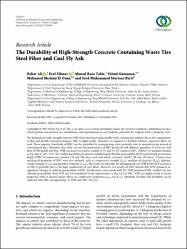| dc.contributor.author | Ali, Babar | |
| dc.contributor.author | Yılmaz, Erol | |
| dc.contributor.author | Tahir, Ahmad Raza | |
| dc.contributor.author | Gamaoun, Fehmi | |
| dc.contributor.author | El Ouni, Mohamed Hechmi | |
| dc.contributor.author | Murtaza Rizvi, Syed Muhammad | |
| dc.date.accessioned | 2022-09-12T11:12:53Z | |
| dc.date.available | 2022-09-12T11:12:53Z | |
| dc.date.issued | 2021 | en_US |
| dc.identifier.citation | Ali, B., Yilmaz, E., Tahir, A.R., Gamaoun, F., El Quni, M.H. & Rizvi, S.M.M. (2021). The Durability of High-Strength Concrete Containing Waste Tire Steel Fiber and Coal Fly Ash. Advances in Materials Science and Engeenering, 2021, 7329685. https://doi.org/10.1155/2021/7329685 | en_US |
| dc.identifier.issn | 1687-8434 | |
| dc.identifier.issn | 1687-8442 | |
| dc.identifier.uri | https://doi.org/10.1155/2021/7329685 | |
| dc.identifier.uri | https://hdl.handle.net/11436/6440 | |
| dc.description.abstract | The demands for high-strength concrete (HSC) have been increasing rapidly in the construction industry due to the requirements of thin and durable structural elements. HSC is highly brittle. Therefore, to augment its ductility behavior, expensive fibers are used. These negative drawbacks of HSC can be controlled by incorporating waste materials into its manufacturing instead of conventional ones. Therefore, this study assessed the performance of HSC produced with different quantities of waste tire steel fiber (WSF) and fly ash (FA). WSF was used at two doses, namely, 0.5% and 1%, by volume in HSC, with low-to-medium volumes of FA, that is, 10%-35%. The studied durability parameters included rapid chloride permeability (RCP) and chloride penetration depth (CPD) by immersion method (28 and 120 days) and acid attack resistance (AAR) (28 and 120 days). Various basic mechanical properties of HSC were also analyzed, such as compressive strength (f(CM)), modulus of elasticity (E-CM), splitting-tensile strength (f(CTM)), and modulus of rupture (f(CRM)). The results revealed that the damaging effect of WSF on the RCP resistance of HSC is probably due to the high conductivity of steel fibers. However, test results of CPD showed that WSF produced insignificant changes in chloride permeability of HSC. Furthermore, when made with FA, WSF-reinforced HSC yielded very low chloride permeability. Both WSF and FA contributed to the improvement in the AAR of HSC. WSF was highly useful to tensile properties while it showed minor effects on compressive properties (f(CM) and E-CM). Optimum ductility and durability can be achieved with HSC incorporating 1% WSF and 10%-15% FA. | en_US |
| dc.language.iso | eng | en_US |
| dc.publisher | Hindawi | en_US |
| dc.rights | info:eu-repo/semantics/openAccess | en_US |
| dc.subject | Mechanical-properties | en_US |
| dc.subject | Reinforced concrete | en_US |
| dc.subject | Silica-fume | en_US |
| dc.subject | High volume | en_US |
| dc.subject | Recycled concrete | en_US |
| dc.title | The durability of high-strength concrete containing waste tire steel fiber and Ccal fly ash | en_US |
| dc.type | article | en_US |
| dc.contributor.department | RTEÜ, Mühendislik ve Mimarlık Fakültesi, İnşaat Mühendisliği Bölümü | en_US |
| dc.contributor.institutionauthor | Yılmaz, Erol | |
| dc.identifier.doi | 10.1155/2021/7329685 | |
| dc.identifier.volume | 2021 | en_US |
| dc.identifier.startpage | 7329685 | en_US |
| dc.relation.journal | Advances in Materials Science and Engeenering | en_US |
| dc.relation.publicationcategory | Makale - Uluslararası Hakemli Dergi - Kurum Öğretim Elemanı | en_US |


















